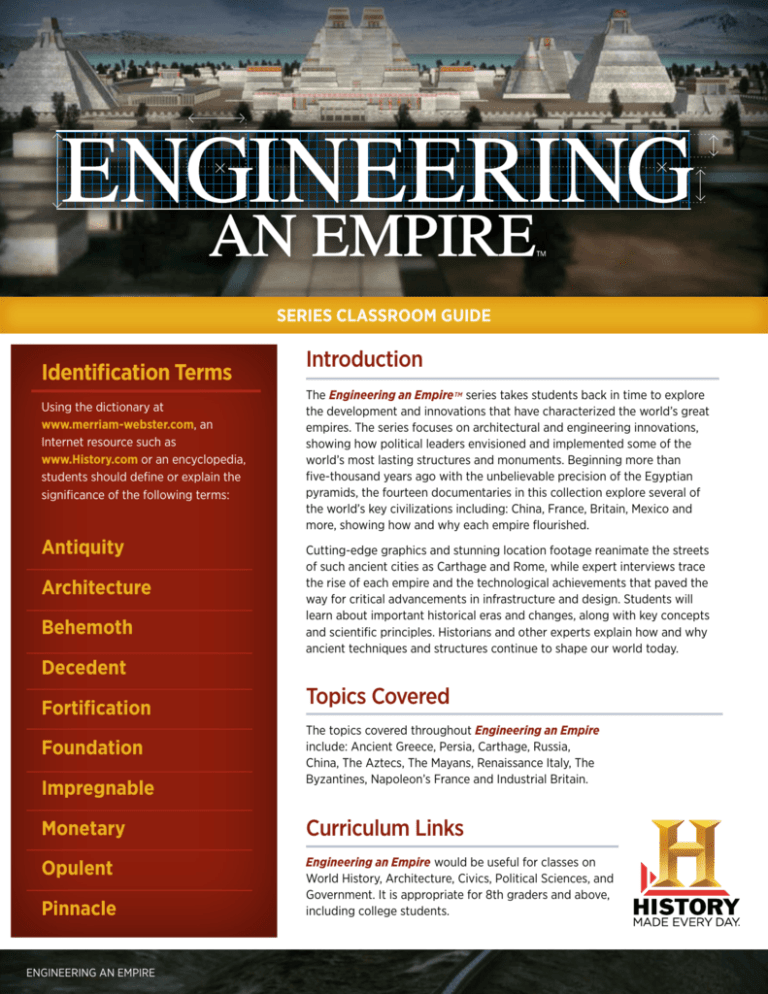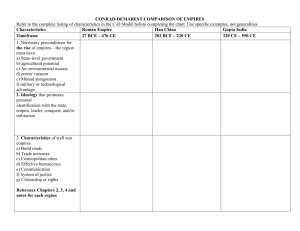
SERIES classroom Guide
Identification Terms
Using the dictionary at
www.merriam-webster.com, an
Internet resource such as
www.History.com or an encyclopedia,
students should define or explain the
significance of the following terms:
Antiquity
Architecture
Behemoth
Decedent
Fortification
Foundation
Impregnable
Introduction
The Engineering an Empire TM series takes students back in time to explore
the development and innovations that have characterized the world’s great
empires. The series focuses on architectural and engineering innovations,
showing how political leaders envisioned and implemented some of the
world’s most lasting structures and monuments. Beginning more than
five-thousand years ago with the unbelievable precision of the Egyptian
pyramids, the fourteen documentaries in this collection explore several of
the world’s key civilizations including: China, France, Britain, Mexico and
more, showing how and why each empire flourished.
Cutting-edge graphics and stunning location footage reanimate the streets
of such ancient cities as Carthage and Rome, while expert interviews trace
the rise of each empire and the technological achievements that paved the
way for critical advancements in infrastructure and design. Students will
learn about important historical eras and changes, along with key concepts
and scientific principles. Historians and other experts explain how and why
ancient techniques and structures continue to shape our world today.
Topics Covered
The topics covered throughout Engineering an Empire
include: Ancient Greece, Persia, Carthage, Russia,
China, The Aztecs, The Mayans, Renaissance Italy, The
Byzantines, Napoleon’s France and Industrial Britain.
Monetary
Curriculum Links
Opulent
Engineering an Empire would be useful for classes on
World History, Architecture, Civics, Political Sciences, and
Government. It is appropriate for 8th graders and above,
including college students.
Pinnacle
ENGINEERING AN EMPIRE
Discussion Questions
1. How does an empire typically begin? What are the signs that one civilization might be poised to become a longlasting empire?
2. W
here are the biggest cities in empires typically located? Why do you think this is? What advantages does the terrain
pose? Disadvantages?
3. W
hy do you think leaders of empires place great importance on building architectural monuments? How do these
monuments shape their legacy? Do you think they intended for the structures to last forever?
4. W
hat costs are involved in building a great structure? Do you think the final product is worth the cost? Why?
5. D
o you think there is a pattern among how the empires featured in this series declined? What are some of
the reasons an empire may lose power? What is left behind by a great empire or culture when it
ceases to exist?
02 ENGINEERING AN EMPIRE
©2012 A&E Television Networks, LLC. All rights reserved.0695.
Extended Activities
1. Charting an Empire. Each program in this series traces
the rise of an empire, exploring key leaders and their
accomplishments. During or after watching one of these
programs, answer the following questions: What time
period does this episode cover? Who were the key
leaders, and what were the major advancements and
innovations of this era? How is this empire remembered
today? How does it compare with others you have
studied?
2. What’s the Source? Historians and other experts use
primary sources to determine new information about
the past. What kinds of sources are used by historians
in this series? Online or at the library, find an additional
primary source related to the topic of the show. These
sources could be a letter, image, poem, painting or any
other primary source. What insight does this source
give you into this culture and time period? Share these
with your larger class or group.
3. W
ho’s Leading? Choose one leader you learned
about by watching a program in this series. Write
a short essay (1-3 pages) on some of the tactics or
accomplishments he or she used in building their
empire. What characteristics made him/her successful?
What were their downfalls or weaknesses?
4. A Favorite. The series explores in great detail many of
the most famous structures ever built. Have you ever
been to one of them? If not, is there one in particular
you would like to visit? Why? Make a short presentation
to the class about a building, monument or historic
site you have seen in person or one you would like to
visit. You can use any form you would like to deliver the
presentation: a model, PowerPoint, a poster or a
short essay.
03 ENGINEERING AN EMPIRE
Books
Harman, Chris. A People’s History of the World: From the
Stone Age to the New Millennium. (Verso, 2008).
Burbank, Jane. Empires in World History: Power and the
Politics of Difference. (Princeton University Press, 2011).
Borden, Daniel, Jerzy Elzanowski, Joni Taylor and Stephanie
Tuerk. Architecture: A World History. (Abrams, 2008).
Salvadori, Mario. The Art of Construction: Projects and
Principles for Beginning Engineers & Architects. (Chicago
Review Press, 2000).
Additional Websites
Ancient History on History.com:
www.History.com/topics/ancient-history
UNESCO World Heritage Centre:
whc.unesco.org
Library of Congress World Digital Library:
www.wdl.org/en
Internet Ancient History Sourcebook:
www.fordham.edu/halsall/ancient/asbook.asp
History of World Empires:
www.AllEmpires.com









